ROUND THE BLOCK
Big Healey guru John Chatham has put together the
ultimate 100/4 using high-tech engineering and a bullet-proof
engine. Mick Walsh prepares for some sideways action
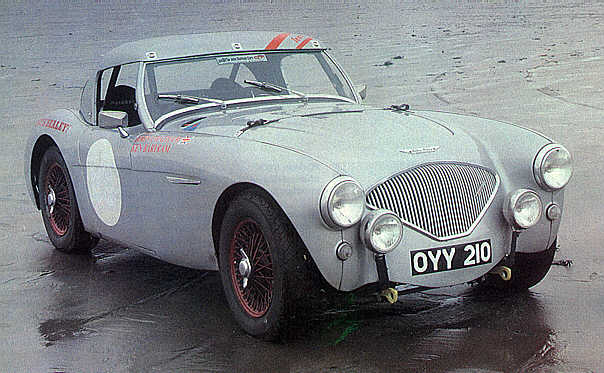
It's difficult to imagine the hearty Healey guru John Chatham
as a 12 year old pedalling down the Gloucester Road. But he still vividly
remembers the day he fell in love with a Healey 100/4: "I was a regular
fixture with my nose pressed against Henlys' showroom window, ogling a
glorious red 100/4 revolving on a plinth. I'm sure its seductive curves
induced my first orgasm," John recalls bursting into laughter.
Close to 40 years later, the bristol-based specialist
is almost as enthusiastic about his first Healey love, having recently
turned his attentions to a pretty 'four' after several decades of setting
the pace on track and stage with his trusty 3000 racers DD 300 and GRX
884D: " My first Healey was a 100/4 and I won awards in just about every
form of motor sport- rallies, driving tests, sprints, races and hill climbs,
and then drove it to work again on monday morning. We'd shave lumps off
the cylinder head to go quicker, but at the circuit it was simply aeroscreens
and taped headlights. Its all-round capability always struck at the back
of my mind."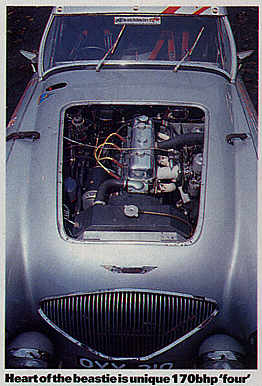
That was back in 1962; it wasn't until last year that
Chatham turned his attention again to the 100/4: " I knew it would never
have the legs on the 3000 for the circuit, but for events like the Classic
Marathon, I always considered it a more nimble car. The long stroke four
has immense torque which provides effective punch when you really need
it - particularly for hairpin bends. My goal was to prove the 100/4 could
be quicker than the 3000."
Last year on the Marathon, John really proved his point.
On the second timed stage in Belgium only the 'flying finn', Timo Makinen
in a Mini Cooper was quicker. First time out of the box the 100/4's potential
was proven, although the rest of the event turned out to be a disaster
for Chatham's immaculate silver machine. On the first stage in England
he holed the sump, and later in Germany a clutch hydraulic failure put
him out of the running.
John's project - the development of the ultimate 100/4
- is essentially based around the 2.5 litre Austin diesel engine as used
in the FX4 London taxi. Geoff Healey had considered this proposal many
years ago when Austin Healeys were still in production.
The Austin diesel engine has a bullet-proof block and
crankshaft to withstand the 22:1 compression ratio necessary to run a compression
ignition engine and therefore overcome the inherent weakness of the original
A90 petrol engine. Both Dave Jeffery of SC Austin Healey Parts and John
Chatham were keen to see if Geoff's original proposals could be made to
work. Design and development started seriously at the beginning of 1990.
It was decided to retain the shorter stroke of the diesel
engine (101.5 mm compared to 111mm for the A90) in order to allow a higher
revving engine and to avoid alterations to the substantial crankshaft.
This is a nitrided EN40B forging with larger bearing sizes than the original.
The block was over bored into the water passages, and then linered using
specially made thick wall liners. These were then bored to virtually 91
mm for a capacity of 2615cc ( compared with 2670cc originally ). Ford Sierra
Cosworth pistons were used and new con rods specially made ( the diesel
rods being much too heavy for a high revving engine).
The top of the diesel block has a multitude of studs,
non of which lined up with the holes for the petrol cylinder head. Two
studs were very close and one of SC's new 100/4 alloy heads was machined
specially to suit these. The rest of the studs in the block face were blanked
off and the remainder of the studs required to fit the head specially drilled.
All of the studs were specially made in EN24 heat treated to 80 tons to
enable torquing up to 125 lb ft. Because of the engine family resemblance,
the pushrod holes and combustion chambers lined up well enough.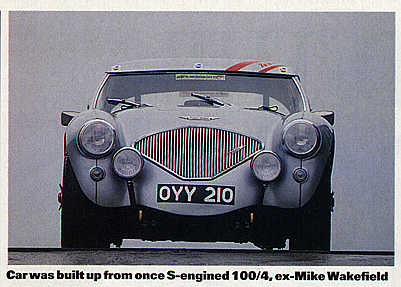
SC had previously spent a considerable a considerable
amount of time and resources with the Institute of Noise and Vibration
at Southampton University. This work had been to overcome various mechanical
failures caused primarily by crankshaft and camshaft torsional vibrations
when the six-cylinder Austin Healey engine was producing large amounts
of power at high revs. Now it was the turn of the four cylinder.
Research with the six-cylinder engines had shown that
only static testing would be required with the four-cylinder diesel crank.
Fortunately, the bullet-proof assembly passed with flying colours, with
the comment that there could be a serious vibration period at 14,000 rpm!
Not a problem.
SC now had a bullet-proof petrol engine but nowhere to
put the distributor ( diesels don't use them ). The distributor probably
could have been fitted under the inlet and exhaust manifold but this was
not considered a viable option. Thus the problem was solved by fitting
the distributor where the injection pump was fitted on the diesel engine.
This meant using the diesel's timing chain layout but this was a heavy
triple chain arrangement designed to run a maximum of about 3500 rpm. A
completely new double chain layout was designed and made using modern dampers
together with a specially designed oil-fed tensioner. A modified VW Golf
distributor is used, pointing backwards from the timing cover under the
dynamo.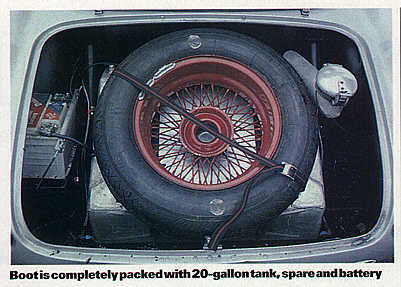
Two 2 inch SU carburettors are used, together with a
very special large bore exhaust manifold. The camshaft is ground to a profile
similar to that used on the last of the works six cylinder competition
cars. About 150 bhp has been recorded at the rear wheels, probably about
170 bhp at the flywheel, at around 6000 rpm. As the engine is quite happy
running up to 7800 rpm there is obviously a lot more development possible.
Larger carburettors ( Weber probably ) together with a much more extreme
camshaft will release a lot more horsepower.
Once dave Jeffrey had completed development of the engine,
John set about preparing a car to use the new levels of power. He had been
saving just such a project for over 20 years, having previously acquired
a well known alloy 100/4 once club raced by Mike Wakefield. Registered
OYY 210 and fitted with a genuine 100S engine, John had made overtures
that he'd be interested in acquiring it if it were ever sold.
Unfortunately he was on holiday when the owner made contact
and by the time john returned the prized engine had been sold separately,
but the rest of the car was soon back in Bristol. Over the years the car
has been pillaged for other restorations but the alloy shroud, doors and
boot were an ideal basis for the new project.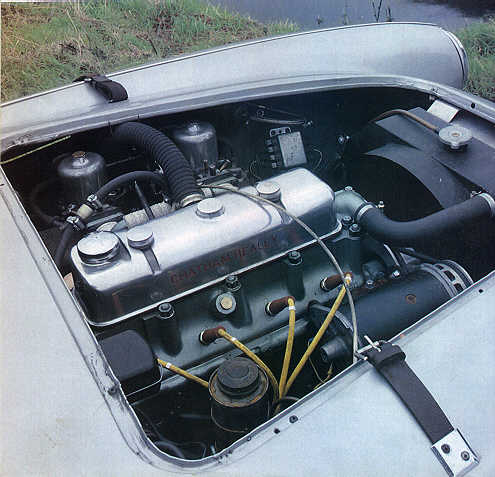
The suspension specification is simple: heavier front
anti-roll bar and stiffer spring rates than standard, and heavy duty shocks
all round. The bushing and locating points are all standard, while a touch
of negative camber is employed at the front. Front discs are Girling MK1
spec with DS11 pads which have always proved effective enough hauling up
the works 3000s. A twin plate competition clutch helps keep the massed
weight down on the crank. Tulip straight cut gears and a competition 22
per cent overdrive provide an ideal set of six ratios to dial in the power,
with the switch mounted on a standard BN2 gear lever.
A 20 gallon tank, 12-volt battery and spare wheel pack
out the boot and leave next to no luggage space. The six point roll cage
is cleverly disguised by a handsome alloy hard top, while the lower front
cross bar proved ideal to mount Halda, navigator light and Speedpilot.
The top also hides the non period high backed Kevlar rally seats but no
sidescreens are fitted as John prefers to enjoy fresh air conditioning,
and resents restricted vision - an important consideration as he tends
to spend most of his driving time sideways. The instrumentation is as stark
as a standard 100/4, but with the installation of a modern rev counter.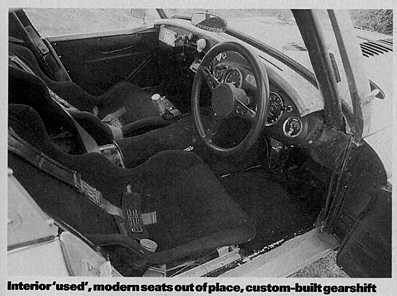
The exhaust is an inspired design by John, who was not
keen on suffering a noisy under door exit or leaving the system on the
road at the first stage. A slightly longer inlet manifold flows into a
large diameter main pipe which is strapped up high to the chassis. The
rear shroud and crossmember have been cut away to gain extra clearance
and, combined with protective skids, the system survived intact after the
demanding conditions of the Marathon. Quite an achievement for any full
length Healey system.
The cars weighs in at 960 kgs compared to 987 kgs of
the standard car, but that's still heavier than the 100S. As with most
competition projects and event deadlines, the preparation of OYY 210 ran
out of time for the Marathon. John would have preferred a longer shakedown
but the finished car looked superb in Mercedes silver with red wires at
Tower Bridge for the start. A holed sump on the first stage in England
was gamefully patched with the help of the unipart service barge, but after
setting a scorching pace through Belgium, those clutch hydraulics failed
in Germany. In the pouring rail John and loyal co-driver Ken Bartram took
the gearbox out at the side of the road, without the co-operation of a
miserable German garage proprietor who refused to open up and allow the
use of his ramp. Although by then well out of the running, the 100/4 continued
to prove it's stamina and potential on the event. The run back with a pair
of 3000s also provided an interesting mpg test. Using accurate mileage's
measured on the speedpilots, the 100/4 returned a healthy 28 mpg compared
to a 23 mpg best by the six.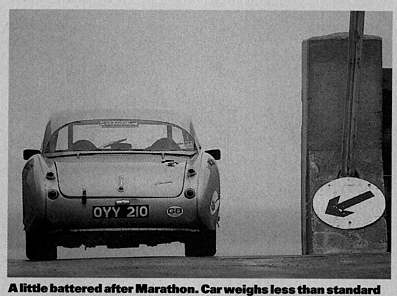
True to the 100/4 experience, the interior leaked like
a colander during downpours, soaking the driver and navigator. Under bonnet
heat is still a continuing problem, particularly in traffic: the radiator
is already extensively ducted by heat outlets are still not enough. Fuel
vaporization is a big problem, particularly when waiting for the start
of a special stage. The exhaust manifold is already wrapped in asbestos,
but the car continues to stutter when the light goes green. A fuel return
system could be the answer in an attempt to keep the gas cool.
John is determined to return and is also considering
a team of 100/4s for next year's Mexican Carrera PanAmerican retrospective,
but since the Marathon disaster OYY 210 has fulfilled all his ambitions
on the circuits. At Mallory Park for a Healey Club Championship round John
debuted the 'diesel', psyching up arch-rival Dave Hardy about his "secret
development engine". Hardy has been campaigning 100/4s for many years,
so holding him off to take second overall first time out was a proud achievement.
The heated 10-lap tussle saw the two cars just 1.5 secs apart at the flag.
Constant lap times of 48 secs were only 2 secs off Chathams Mallory best
with DD 300.
Other highlights of 1991 were the Last Healey race of
the season at Castle Combe when, in a father and son challenge against
the Welch and Hardy clans, Joe Chatham in his first ever race came home
sixth with OYY 210. Dad couldn't catch Dennis Welch but Joe headed the
other sons to take overall glory for the Chathams. Next came a visit to
the isle of white for the traditional Healey Club weekend which provided
the opportunity for Geoff Healey to test the car. He returned after a brisk
drive, and in his usual guarded manner just hummed and puffed on his pipe,
without forwarding any definite judgement. However, about half an hour
later he returned and complimented John that he thought "the engine was
fantastic". He said it immediately reminded him of x224, the modified 100S
chassis that the Cape works fitted with a Ferrari 2.5 litre, four cylinder
F1 engine. High praise for the Austin diesel based unit.
As for John, well he'd still rather drive a 3000 on the
circuit - namely his treasured evergreen racer DD 300: " I'm a sucker for
its ultimate grunt, but the 100/4 is the best all round Healey. It's so
easy to drive and the new engine has definitely cured the lazy response
of the four without loosing that desirable low down torque. This one still
really thumps from low revs. Everybody still considers them the pretty,
no go Healey that could be licked by a TR, but we've certainly woken this
one up. All the effort of the development has been worth it just to prove
that. And I enjoy driving it more than GRX", John concluded. And for anyone
who understands John's long affection for his 3000 rally warrior, that
is quite a conversion.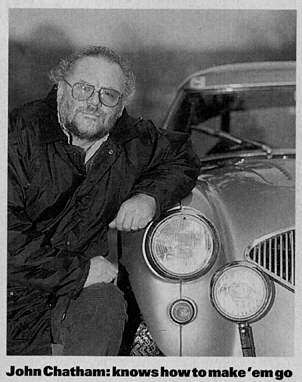 Driving The Chatham Healey 100/4
To my mind the 10/4's cockpit lacked sporting charisma at
the best of times. Gerry Coker's original styling sketches had a flashy
American look, but the end result was basic and simple. Chatham's warrior
is functional to the last with roughly cut carpets and black satin paint
finnish on the dash and panels. Already the worn and scratched interior
indicates the tough action this pretty car has already encountered.
Driving The Chatham Healey 100/4
To my mind the 10/4's cockpit lacked sporting charisma at
the best of times. Gerry Coker's original styling sketches had a flashy
American look, but the end result was basic and simple. Chatham's warrior
is functional to the last with roughly cut carpets and black satin paint
finnish on the dash and panels. Already the worn and scratched interior
indicates the tough action this pretty car has already encountered.
Apart from the modern tacho, standard dials straddle
the thick small leather rimmed wheel, while a large orange oil pressure
warning light sits dead centre. Spread across the normally bare curve of
the dash to the passenger's door are indicator knob, master switch and
extra horn, while the Halda rally equipment is hung underneath on the rollover
bar brace.
The gearstick is crooked well back to the driver's side
and topped with a spun aluminium knob cleverly incorporating the overdrive
switch. The plain door pockets are the only storage space, while inside
is a cable door pull which aids rapid navigator exit to stop the clock
at the end of a special stage.
The modern high backed rally seats are as tight fitting
and as superbly supportive as you would expect. But in a fifties car, I
can't forgive their unsuitable image, although thankfully the hard top
hides them away. Strapped up in the harness, the driving position is still
typically Healey - seated flat and low with legs straight and elbows bent
for the close wheel. There's little to get nostalgic about in this gutted
cabin as supreme function is the primary concern. So down to business:
turn the centre ignition key, press the starter button and after a couple
of churns the engine catches, sounding gruff and lumpy, more like a rally
Escort than sporty Austin. Flex your right foot and the engines reformed
response is instantly apparent, so much more revvy than the Agricultural
fours I've previously encountered.
Out on the Road and opened up, the engine is little short
of sensational, particularly in such responsive chassis. It takes a while
to adjust to the extra revs in the 100/4 - changing up at 5500/6000 rpm
rather than the standard 4000 rpm - but little of the engines low-down
urge has been lost with the extra flexibility. But from 4000 rpm you really
feel the power delivery as it spins to unheard of rev limits for such a
humble truck engine. With close-cut ratios, the normally sluggish BN2 gear
change is no handicap, and up to 60 mph, it could shave at least a second
of a 100S. John reckons she's good for 7 secs, but the engines wide power
spread is it's big appeal. The purists will decry its new performance as
erroneous to the true character of the 100/4, but I bet Geoff Healey wished
he'd pursued the development of the diesel after he'd sampled Chathams
racer.
The combination of the direct steering, the bite of the
improved brakes, the neutral chassis balance and the rapid six-speed with
its trigger overdrive ratios inspires confidence. Even on the slippery,
desolate roads down by the Severn estuary, this superbly sorted machine
was irresistible. Dialling in the ratios with the engine singing at the
top end, it feels and sounds proudly exotic. Later, watching John play
to the photographer, powering through the turns and flicking the tail out
on the damp roads, the exhaust rasp sounded more Moderna than Warwick.
With John's enthusiasm for the project, it's a sound we shall hear regularly
setting the pace on stage and track - when he can keep the wheels on the
ground........
Mick Walsh
Article written by Mick Walsh and published in the March 1992
edition of Classic and Sportscar magazine
Home








